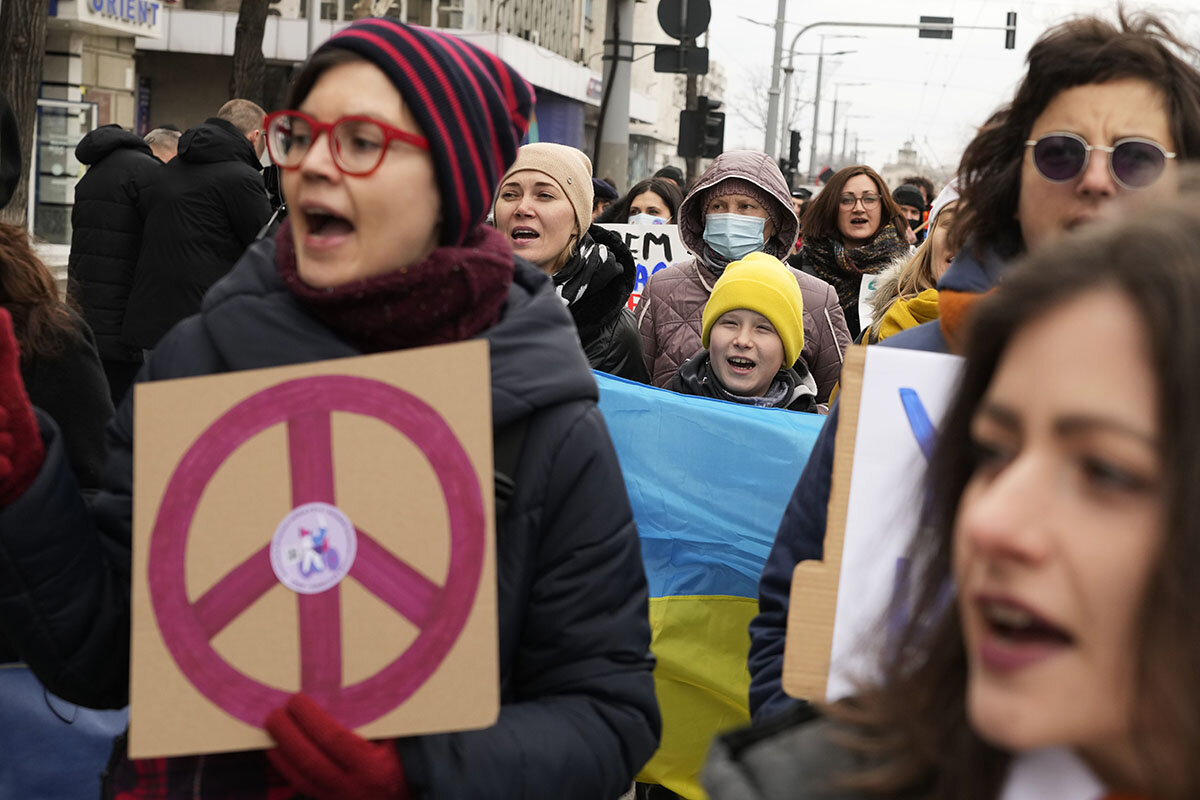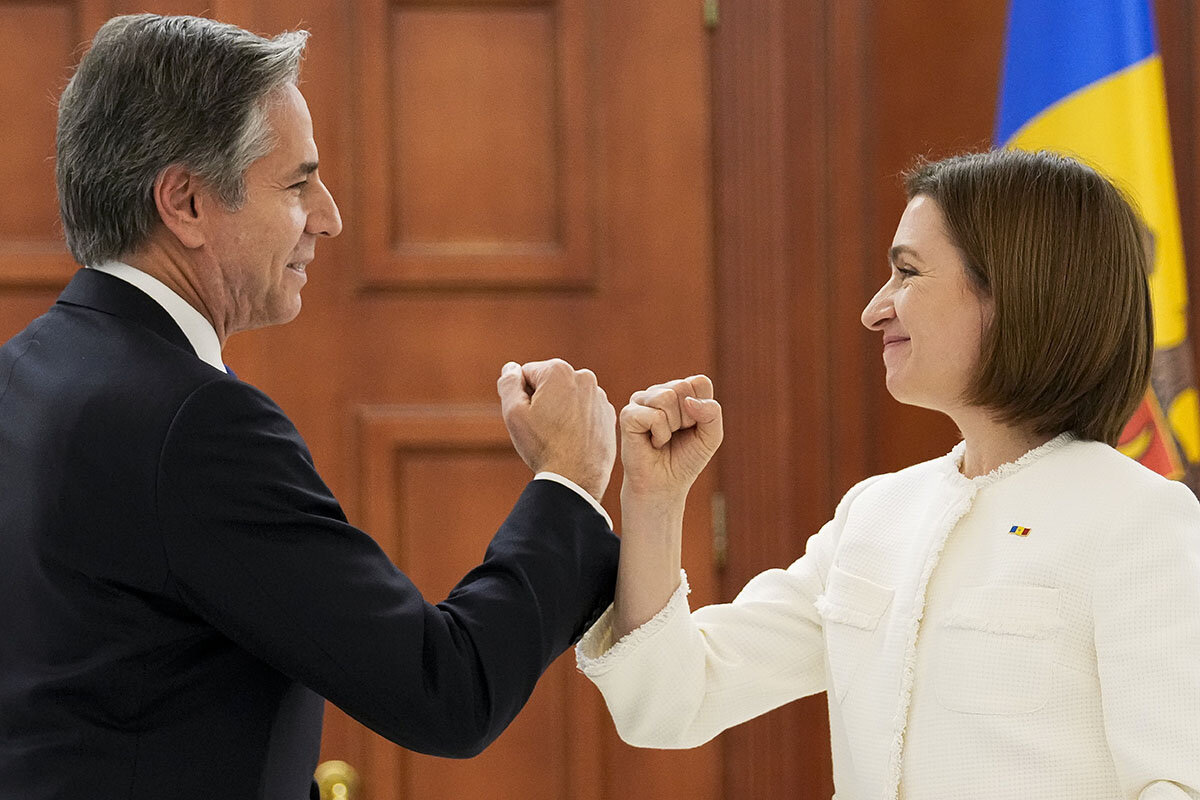Moldovans worry they may be next Putin target
Loading...
| Chisinau, Moldova
The foreign minister of Moldova, a country of 2.5 million people on the western flank of Ukraine, does not mince his words. The Moldovan army, he admits, is small and ill-equipped.
“We are not a very big country and we do not have a very well-endowed army with sophisticated equipment,” Nicu Popescu said in a recent briefing in the Moldovan capital of Chisinau, a city of hulking Soviet-era government buildings, broad boulevards, and snow.
He was responding to questions about whether this small nation, which is squeezed between Ukraine and Romania, might be the next target after Ukraine on Vladimir Putin’s menu.
Why We Wrote This
Does Vladimir Putin have Moldova in his sights? The tiny pro-Western country bordering Ukraine is afraid so, and has no way of defending itself.
There is intense speculation that if Russian forces are able to take the port city of Odessa, in southern Ukraine, they might push westward and cross the border into Moldova.
In the early hours of Wednesday, Russian warships fired missiles at Tuzly, southwest of Odessa on the Black Sea coast, 50 miles from the Moldovan border.
For Moldovans, there are alarming parallels between their country and Ukraine.
Like Ukraine, Moldova was once part of the Soviet Union, gaining its independence in 1991 when the USSR disintegrated.
Like Ukraine, it is not a member of either NATO or the European Union – meaning it could not expect the protection of either bloc in the event of a Russian invasion.
And as with the separatist regions of Donetsk and Luhansk in Ukraine, Moldova has a pro-Moscow, breakaway region within its borders that is occupied by Russian troops.
The region, called Transnistria, runs in a strip down eastern Moldova, along the frontier with Ukraine. When the region announced that it was splitting from the rest of Moldova in 1991, a brief war broke out in which hundreds of people died. No country recognizes tiny Transnistria as an independent state – not even Russia.
In a throwback to Soviet times, it has a hammer and sickle on its flag, statues of Lenin still standing in its squares, and streets named after Marx and Engels.
The territory, which lies on either side of the Dniester River, hosts a garrison of around 1,300 Russian and local troops, as well as a huge stockpile of 20,000 tons of weapons.
If the Russians did swallow up Transnistria – or indeed the whole of Moldova – they could use the territory as a springboard from which to open a new front in Ukraine.
Moldovans were deeply alarmed two weeks ago when Russia’s apparent battle plan for the region was revealed by Alexander Lukashenko, the authoritarian ruler of Belarus.
A close ally of President Putin, the dictator was seen standing in front of a map with arrows that represented Russian lines of attack pointing from southern Ukraine into Moldova.
“I was afraid when I saw Lukashenko and the map with the arrow pointing toward Moldova,” says Aline Frunza, while taking refuge in a cafe in Chisinau from a snow storm outside as the temperature plunged to 23 degrees.
“If Russia invades, we can do nothing,” says the lawyer, as waitresses serve up plates of pancakes and pizza in the brightly lit restaurant. “A lot of Moldovans are leaving the country because of the situation,” she adds. “Others are packing their bags in case there is an emergency.”
While some Moldovans flee west, more than 300,000 refugees have crossed the eastern border with Ukraine. The streets of Chisinau are clogged with cars bearing Ukrainian number plates and miniature blue and yellow Ukrainian symbols.
“A lot of people are in transit. They’re moving through Moldova to places like Romania,” says Andre, a businessman who fled Odessa a few days after the war started.
A country that is normally given scant attention on the international stage has now been pitched into the front line of the biggest conflict in Europe since the World War II.
“Get familiar with Transnistria. You’ll soon be hearing a lot more about it,” Republican Sen. Marco Rubio wrote in a recent tweet.
Nicholas Myers, a senior fellow at Strategy and Future, a think tank in Warsaw, Poland, thinks it is likely that Russia will move on Transnistria, but less probable that Moscow would try to seize the whole of Moldova.
If Russia were able to occupy the Odessa region in southern Ukraine, a linkup with Transnistria might be irresistible, he predicts. “I think that is quite likely. If the Russians take Odessa, that puts them right next to Transnistria,” he says.
One Western diplomat in Chisinau agrees. “I think there’s a very good chance that he would” seek to capture Transnistria “even though it is still a de jure part of Moldova,” he says. “I don’t think Putin would be able to resist the temptation. It would be very provocative.”
He also believes that the likelihood of Russia invading the whole of Moldova is a more distant prospect, but that if it came to pass, “Moldova couldn’t really put up much resistance.”
“Its military has very little kit, there’s no air force, and it has missiles so old that when you fire them in one direction they go off in another because the guidance systems are degraded,” he says.
The Russian objective would be to unseat Moldova’s current pro-Western government and replace it with a pro-Russia administration. To thwart any such plans, Moldova has been lavished with an unusual level of attention by a stream of Western leaders in the past two weeks.
They included Josep Borrell, the EU’s foreign policy chief; Annalena Baerbock, Germany’s foreign minister; and Antony Blinken, the U.S. secretary of state, who said, “We stand with Moldova and any other country that may be threatened in the same way.”
What that means in practice is hard to say. NATO has refused to fight to defend Ukraine, so would not be expected to commit troops to save Moldova.
Western countries are pledging money and humanitarian supplies, but cash and kind words go only so far. If Mr. Putin does decide to invade, “the fate of Moldova is whatever Putin’s whim happens to be,” forecasts Mr. Myers. “If he decides, ‘what the hell,’ then there’s really nothing to stop the Russians.”










